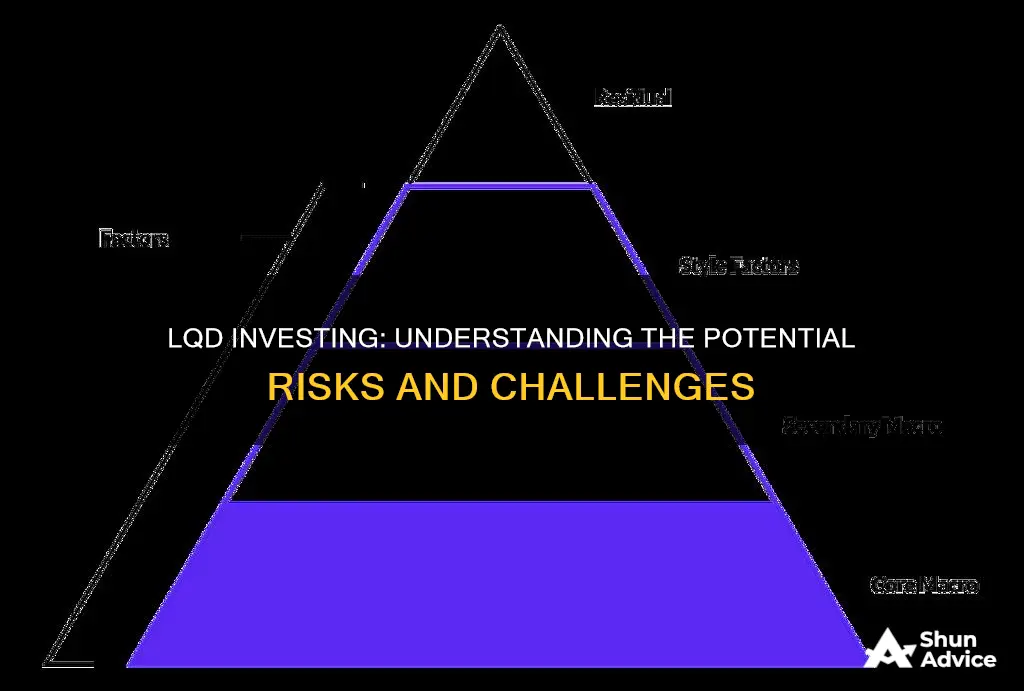
When considering investing in LQD, it is important to be aware of the associated risks. LQD, or the iShares iBoxx $ Investment Grade Corporate Bond ETF, is an exchange-traded fund (ETF) that focuses on investment-grade corporate bonds. While it offers benefits such as diversification and liquidity, there are some key risks to keep in mind. One of the primary risks is interest rate risk—when interest rates rise, bond prices tend to decline, negatively impacting the value of LQD shares. Conversely, when interest rates fall, bond prices generally rise, leading to potential gains. Another risk is credit risk. Although LQD focuses on investment-grade bonds, there is still a possibility of default by the bond issuers, and a downgrade in the credit rating of a bond held by the ETF can also affect its value. Additionally, it is important to monitor the fund's exposure to the banking sector, as a future financial crisis could impact the ETF's value and income if bank issuers cannot pay their debts. As with any investment, thorough research and consideration of your financial goals are essential before making decisions.
| Characteristics | Values |
|---|---|
| Ticker Symbol | LQD |
| Type | ETF (Exchange-Traded Fund) |
| Description | iShares iBoxx $ Investment Grade Corporate Bond ETF |
| Focus | Investment-grade corporate bonds |
| Index | Markit iBoxx USD Liquid Investment Grade Index |
| Risk | Interest rate risk, credit risk |
| Management | Passively managed |
| Issuer | BlackRock |
| Holdings | ~1,750 investment-grade corporate bonds |
| SEC Yield | 3.44% |
| Credit Quality | 84.5% of holdings rated A or BBB |
| Duration | 8.3 years |
| Expense Ratio | 0.14% |
| Assets Under Management (AUM) | $28 billion |

Interest rate risk
LQD, with its focus on investment-grade corporate bonds, aims to provide investors with a stable and diversified income stream. However, the impact of rising interest rates on bond prices can introduce volatility and affect the overall returns of the fund. As interest rates increase, the opportunity cost of holding bonds becomes higher, as investors can earn a higher return by investing in other interest-bearing assets. This can lead to a decrease in demand for bonds, causing their prices to fall.
The sensitivity of bond prices to changes in interest rates is influenced by the duration of the bonds. Longer-term bonds are more sensitive to interest rate changes than shorter-term bonds, as their prices have a larger adjustment to make to align with the new interest rate environment. LQD's effective duration of almost 8.3 years places it in the middle part of the yield curve, indicating that it is not a short-term or low-duration product.
It is important for investors to consider the potential impact of interest rate risk on their investment in LQD. While the fund offers exposure to a diversified portfolio of investment-grade corporate bonds, the value of these bonds can be significantly affected by changes in interest rates. This risk is inherent in the nature of bond investments and needs to be carefully evaluated when considering an investment in LQD or any other bond-focused fund.
Risk Influences: Impacting Investment Decisions and Strategies
You may want to see also

Credit risk
LQD's focus on investment-grade bonds helps to mitigate some of the credit risks associated with fixed-income investments. The bonds held by LQD are typically issued by companies with strong credit ratings, which reduces the likelihood of default. According to one source, just over 84.5% of LQD's holdings are rated A or BBB, indicating a high level of credit quality. However, it is important to remember that credit ratings are not a guarantee of performance, and there is always a possibility of a downgrade in credit rating or default.
In addition to the risk of default, credit risk can also affect the value of the LQD ETF. A downgrade in the credit rating of a bond held by the ETF can lead to a decline in its value. This is because credit ratings are a key factor in determining the yield and price of a bond. A lower credit rating typically results in a higher yield, as investors demand a higher return for taking on additional risk. This can impact the overall performance of the LQD ETF, as it seeks to replicate the performance of the underlying index, which includes bonds with investment-grade ratings.
Furthermore, credit risk can also impact the liquidity of the LQD ETF. While the ETF provides liquidity, allowing investors to buy and sell shares during market hours, this liquidity can be affected by the credit quality of the underlying bonds. If there is a significant decline in the credit quality of the underlying bonds, it may lead to reduced trading volumes and potentially impact the ease of buying and selling the ETF.
Overall, while LQD's focus on investment-grade corporate bonds helps to mitigate credit risk, it is still a factor that investors should carefully consider before investing. Understanding the credit risk associated with LQD is crucial for making informed investment decisions and managing the potential risks within an investment portfolio.
Bridgewater's Investment Decision-Making: Strategies and Secrets
You may want to see also

Default risk
Firstly, there is a possibility of default by the bond issuers. This means that the companies issuing the bonds may fail to make interest or principal payments on time or at all. This risk is inherent in any fixed-income investment and needs to be carefully assessed. The likelihood of default can be influenced by various factors, such as economic conditions, industry-specific challenges, or individual company financial health.
Secondly, a downgrade in the credit rating of a bond held by the ETF can also impact its value. Credit ratings are not static and can change over time. If a bond issuer experiences financial difficulties or adverse economic conditions, their credit rating may be downgraded, leading to a potential decrease in the value of the bond. This, in turn, can affect the overall performance of the LQD ETF.
Additionally, it's important to consider the underlying index that LQD tracks, which primarily consists of investment-grade corporate bonds. While this provides a level of stability, investors should be aware that the index's composition may change over time. The inclusion or exclusion of certain bonds in the index can impact the overall risk profile of the ETF.
Furthermore, the performance of the LQD ETF is closely tied to the credit quality of the underlying bonds. A deterioration in the credit quality of the bonds, even if they remain investment-grade, can increase the default risk. Investors should regularly monitor the credit quality of the bonds held by the ETF to assess this risk.
Lastly, it's worth noting that LQD's focus on investment-grade corporate bonds may limit its ability to capture higher returns. While these bonds offer stability and lower default risk, they may provide lower yields compared to high-yield or junk bonds. Investors seeking higher returns may need to consider other investment options or a more diversified bond ETF that includes a mix of investment-grade and high-yield bonds.
Investment Management Services: Your Wealth, Our Priority
You may want to see also

Liquidity risk
LQD is also the ticker symbol for the iShares iBoxx $ Investment Grade Corporate Bond ETF, an exchange-traded fund (ETF) that focuses on investment-grade corporate bonds. This ETF provides investors with exposure to a diversified basket of high-quality corporate bonds, aiming to track the performance of the iBoxx $ Liquid Investment Grade Index.
While the ETF offers potential benefits such as income generation and diversification, it is essential to consider the associated risks. One of the primary risks of investing in LQD is interest rate risk. When interest rates rise, bond prices tend to decline, negatively impacting the value of LQD shares. Conversely, falling interest rates can lead to potential gains.
Another critical risk factor to consider is credit risk. Although the ETF focuses on investment-grade corporate bonds, there remains a possibility of default by the bond issuers. A downgrade in the credit rating of a bond held by the ETF can also adversely affect its value.
Therefore, investors must carefully evaluate their risk tolerance, investment objectives, and conduct thorough research before investing in the LQD ETF or any other financial instrument.
Strategizing a Balanced Investment Portfolio at 67 Years Old
You may want to see also

Inflation risk
To mitigate inflation risk, investors often look for investments that offer a variable interest rate or a return that is linked to inflation. However, investment-grade corporate bonds, like those held by LQD, typically have fixed interest rates. As a result, during periods of high inflation, the purchasing power of the interest income generated by LQD's bond holdings may decrease. This can negatively impact the overall return of the investment and affect the investor's purchasing power.
Additionally, in an inflationary environment, central banks often respond by increasing interest rates to curb rising prices. While this can help combat inflation, it can also lead to a decline in bond prices, including those held by LQD. When interest rates rise, bond prices tend to fall, as newer bonds are issued with higher interest rates, making the existing bonds less attractive. As a result, the market value of LQD's bond holdings may decrease, impacting the overall value of the investment.
It is important to note that while inflation risk is a consideration, it should be assessed alongside other risks and potential returns. LQD, for example, offers diversification benefits and exposure to a basket of high-quality corporate bonds. Additionally, during periods of low inflation or deflation, the fixed interest rate of investment-grade corporate bonds can provide a stable and attractive income stream.
In conclusion, investors considering LQD should carefully evaluate the potential impact of inflation on their investment. While LQD offers exposure to investment-grade corporate bonds and potential income generation, the fixed nature of the interest payments can lead to a decline in the real value of the income stream during periods of high inflation. Therefore, it is crucial for investors to assess their risk tolerance, investment objectives, and the current economic environment before making any investment decisions.
Understanding Investment Management Mandates: Your Money, Your Rules
You may want to see also
Frequently asked questions
LQD is the ticker symbol for the iShares iBoxx $ Investment Grade Corporate Bond ETF. It is an exchange-traded fund (ETF) that focuses on investment-grade corporate bonds.
The primary risks of investing in LQD are interest rate risk and credit risk. When interest rates rise, bond prices tend to decline, negatively impacting LQD's value. There is also a possibility of default by bond issuers, affecting the ETF's value.
Investing in LQD offers exposure to a diversified portfolio of investment-grade corporate bonds, providing potential income and reducing risk. LQD also offers liquidity, transparency, and relatively low expense ratios compared to actively managed funds.
You can buy LQD shares through a brokerage account. First, open and fund a brokerage account, then determine your budget and research the investment. Finally, place an order through your brokerage account's order page.







